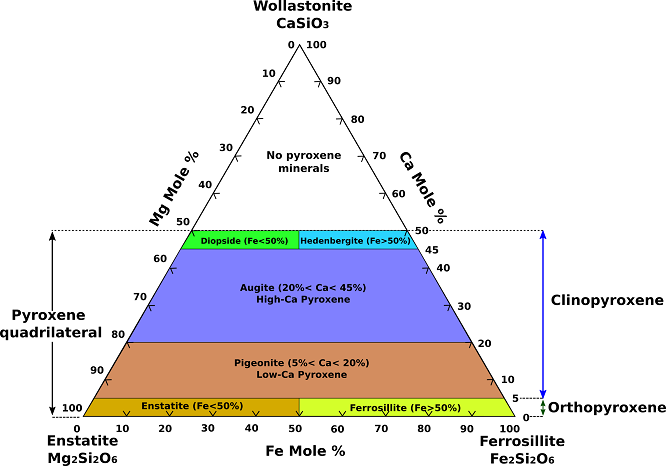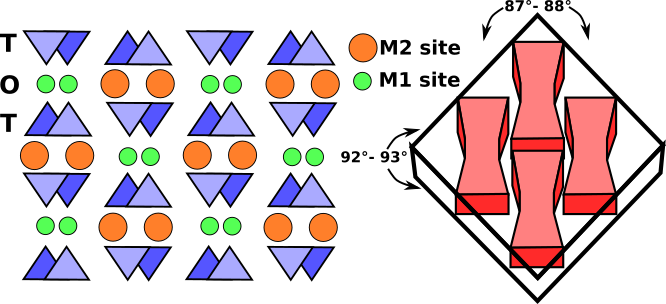The Pyroxene Mineral Group
Pyroxenes are the most significant and abundant group of rock-forming ferromagnesian silicates. They are found in almost every variety of igneous rock and occur in rocks of widely different compositions formed under conditions of regional and contact metamorphism. The name pyroxene is derived from the Greek pyro, meaning "fire", and xenos, meaning "stranger", and was given by Haüy to the greenish crystals found in many lavas which he considered to have been accidentally included there.TThe chemical composition of minerals of the pyroxene group can be expressed by the general formula:
XYZ2O
in which X = Na+, Ca2+, Mn2+, Fe2+, Mg2+, Li+; Y = Mn2+, Fe2+, Mg2+, Fe3+, Al3+, Cr3+, Ti4+; and Z= Si4+, Al3+. The range of possible chemical substitutions in pyroxene is constrained by the sizes of the available sites in the structure and the charge of the substituting cations. The X-cation sites in general are larger than the Y-cation sites. Extensive atomic substitution occurs between the ideal end-member compositions. Most pyroxenes have only limited substitution of aluminum for silicon in the Z (tetrahedral) site. When a substituting ion differs in charge, electrical neutrality is maintained by coupled substitutions. For example, the pair consisting of Na+ and Al3+ substitutes for 2Mg2+.
The most common pyroxenes can be represented as part of the chemical system CaSiO3 (wollastonite, a pyroxenoid), MgSiO3 (enstatite), and FeSiO3 (ferrosilite). (Fig.1). Since no true pyroxenes exist with calcium contents greater than that of the diopside-hedenbergite join, the part of this system below this join is known as the pyroxene quadrilateral.

Fig.1: Ternary Composition Diagram for Pyroxenes.
Complete substitution exists between enstatite (Mg2Si2O6) and ferrosilite (Fe2Si2O6), and complete solid solution of iron for magnesium exists between diopside (CaMgSi2O6) and hedenbergite (CaFeSi2O6). Augite, subcalcic augite, and pigeonite lie within the interior of the pyroxene quadrilateral. Compositionally, augite is related to members of the diopside-hedenbergite series with limited substitution of Na+ for Ca2+, Al3+ for Mg2+ and Fe2+, and Al3+ for Si4+ in the Z (tetrahedral) site. Augites with substantial aluminum or sodium cannot be strictly represented in the quadrilateral plane. Monoclinic pigeonite encompasses a field of magnesium-iron solid solution with a slightly higher calcium content than the orthorhombic enstatite-orthoferrosilite series.
Coupled substitutions involving Na+, Li+, or Al3+ for Mg2+ in the enstatite structure yield pyroxenes that lie outside the quadrilateral compositional field. The coupled substitution of Na+ and Al3+ for 2Mg2+ in enstatite produces the pyroxene jadeite. The coupled substitution of Na+ and Fe3+ for 2Mg2+ produces the pyroxene aegirine (acmite). Substitution of Li+ and Al3+ for 2Mg2+ yields spodumene. The substitution of Al3+ for Mg2+ and Al3+ for Si4+ yields the ideal tschermakite component MgAlSiAlO6. Other less common pyroxenes with compositions outside the pyroxene quadrilateral include johannsenite [CaMnSi2O6], and kosmochlor (ureyite) [NaCrSi2O6]. Johannsenite involves the substitution of manganese for iron in hedenbergite. Kosmochlor has chromium (Cr) in place of iron or aluminum in a sodic pyroxene.
At high temperatures, pyroxenes have more extensive fields of solid solution than they do at lower ones. Consequently, as temperatures decrease, the pyroxene adjusts its composition in the solid state by exsolving a separate phase in the form of lamellae within the host pyroxene grain. The lamellae are exsolved along specific crystallographic directions, producing oriented intergrowths with parallel and herringbone texture. There are five principal combinations of exsolution pairs: (1) augite with enstatite lamellae, (2) augite with pigeonite lamellae, (3) augite with both pigeonite and enstatite lamellae, (4) pigeonite with augite lamellae, and (5) enstatite with augite lamellae.
The pyroxenes differ compositionally from the amphiboles in two major respects. Pyroxenes contain no essential water in the form of hydroxyls in their structure, whereas amphiboles are considered to be hydrous silicates. The second key chemical difference between the two is the presence of the A-site in amphiboles which contains the large alkali elements, typically sodium and at times potassium; the pyroxenes do not have an equivalent site that can accommodate potassium.
Structure
The pyroxene group includes minerals that form in both the orthorhombic and monoclinic crystal systems. Orthorhombic pyroxenes are referred to as orthopyroxenes, and monoclinic pyroxenes are called clinopyroxenes. The essential feature of all pyroxene structures is the linkage of the silicon-oxygen (SiO4) tetrahedrons by sharing two of the four corners to form continuous chains. The chains, which extend indefinitely parallel to the c-crystallographic axis, have the composition of (Si2O6) (Fig.2). A repeat distance of approximately 5.3 Å along the length of the chain defines the c-axis of the unit cell. The Si2O6 chains are bonded to a layer of octahedrally coordinated cation bands which also extend parallel to the c-axis..png)
Fig.2: schematic diagram of the single chain pyroxene structure. Where two tetrahedra touch, they share an oxygen ion. From Wikipedia
The octahedral strips consist of M1 and M2 octahedrons sandwiched between two oppositely pointing tetrahedral chains. The M1 sites are occupied by smaller cations such as magnesium, iron, aluminum, and manganese, which are coordinated to six oxygen atoms to form a regular octahedron. In monoclinic pyroxenes, the M2 site is a large irregular polyhedron occupied by the larger calcium and sodium cations which are in eightfold coordination. In the low-calcium orthorhombic pyroxenes, M2 contains magnesium and iron, and the polyhedron takes on a more regular octahedral shape. The M1 cation strip is bonded to oxygen atoms of two oppositely pointing tetrahedral chains (Fig.3). Together, these form a tetrahedral-octahedral-tetrahedral (t-o-t) strip. A schematic projection of the pyroxene structure perpendicular to the c-axis and the relationship of the pyroxene cleavage to the t-o-t strips or I-beams is shown in Fig. 3.

Fig.3: Schematic projection of the monoclinic pyroxene structure perpendicular to the c-axis. T-O-T strips, called I-beams, have very strong bonds that resist breaking and produce the typical near 90° cleavage of pyroxenes (dashed lines).
In thin sections, monoclinic pyroxenes are distinguished by two directions of cleavage at approximately 87° and 93°, eight-sided basal cross sections, and light brown or green colour. Orthorhombic pyroxenes differ from monoclinic pyroxenes in that they have parallel extinction.
Bibliography
• Deer, W.A., Howie, R.A., Zussman, J. (1998) Rock-forming Minerals.
• Phillips, W. R., & Griffen, D. T. (1981). Optical mineralogy: The nonopaque minerals.
• William B. Simmons: Pyroxene, Encyclopędia Britannica. Encyclopędia Britannica, inc. April 07, 2014
Bibliography
• Deer, W.A., Howie, R.A., Zussman, J. (1998) Rock-forming Minerals.
• Optical Mineralogy : The Nonopaque Minerals by Phillips / Griffen
• E. WM. Heinrich (1956): Microscopic Petrografy. Mcgraw-hill book company,inc
• Stephen. A. Nelson

